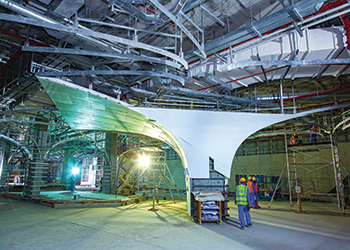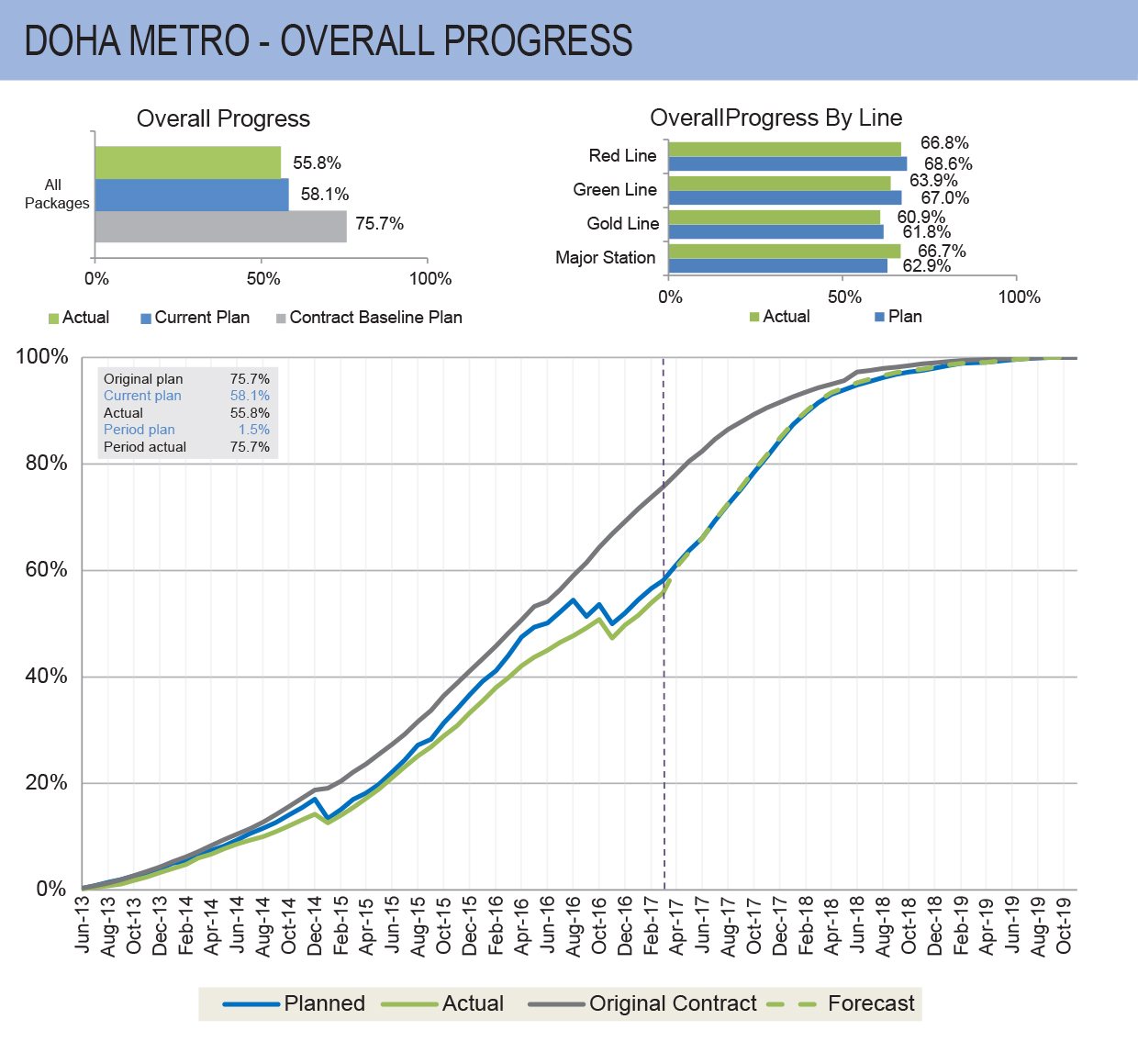
 A Doha Metro station ... work in progress.
A Doha Metro station ... work in progress.
Phase One of the ambitious Doha Metro is progressing well as is work on Lusail LRT. Both stand at more than 50 per cent complete. Next up is the long distance rail, writes ABDULAZIZ KHATTAK.
Work on Qatar Rail’s Doha Metro and Lusail Light Railway Transit (LRT) projects has passed the half-way mark on the under-construction phases with hundreds of millions of man-hours invested and key milestones expected to be achieved this month.
By the end of March 2017, the first phase of Doha Metro had achieved an overall 55.8 per cent completion. The entire tunnelling works for this phase – extending a total distance of 111.504 km – were completed last September using 21 tunnel boring machines (TBM).
The metro is being built in two phases. Phase One will see the construction of three (Red, Gold, and Green) of the four lines and 37 stations. These lines are expected to open by 2020. The second phase will be completed by 2026, and will involve the extension of the Phase One lines and construction of an additional one – the Blue Line. Another 72 stations will also be built.
A total of 10 consortiums are working on various packages of Phase One work.
The Red line is being built by ISG JV (North Underground), Rizzani De Echer‐Lotte‐Redco JV (North Elevated and At Grade), RLS JV (South Underground) and FYAP JV (South Elevated and At Grade), while the Green line is being built by PSH JV (Underground), and SPH JV (Elevated and At Grade).ALYSJ JV is working on the Gold Line Underground, Consolidated Contractors Company (CCC) on the major stations, and MMHKT on the systems.
ISG is a consortium of Salini Impregilo, SK Engineering & Construction, and Galfar Al Misnad; RLS includes QDVC, GS Engineering & Construction and Al Darwish Engineering; FYAP comprises FCC Construction, Yuksel Insaat, Archirodon and Petroserv; ALYSJ comprises Aktor, Larsen & Toubro, Yapi Merkezi Insaat, STFA and Al Jaber Engineering; PSH and SPH are consortiums comprising Porr Bau, Saudi Binladin Group and Hamad Bin Khalid; and MMHKT includes Mitsubishi Heavy Industries, Mitsubishi Corporation, Hitachi, Kinki Sharyo Company and Thales Canada.
“To date 253,291,936 man-hours have been invested on the metro project – 13,850,239 in March alone. The Lusail LRT project has clocked 47,308,656 man hours,” says a spokesman for Qatar Rail.
Overall, the packages are 55.8 per cent complete, with the Red Line currently 66.8 per cent complete, Green Line 63.9 per cent, Gold Line 60.9 per cent, and major stations 66.7 per cent complete.
Turning to the construction of stations, the spokesman says overall work is 53.7 per cent complete. Structural works (walls, columns, slabs and piers) have been finalised on 24 of the stations, and is ongoing on the rest. The roof slab is complete on 18 underground stations while the platform deck slab is complete on five elevated stations. The MEP (mechanical, electrical and plumbing) works are progressing on 35 out of 37 stations, with overall progress standing at 26 per cent as of March end. Architectural works have started on 35 out of 37 stations.
Commenting on stations on the Red Line, he indicates that ceilings installation work has commenced at Al Bidda station (North Underground), while blockwork installation is under way at Lusail Station (North Elevated and At Grade). Ceiling and wall support framing has also started at Al Doha Al Jadeda and Al Matar stations on (South Underground); terazzo floor fit-out and ceiling works are ongoing on all stations of the (South Elevated and At Grade). Meanwhile, blockwork, plasterworks, undercoating, and screed works have been completed on the Green Line Elevated and At Grade stations.
Also, overall viaduct construction is 100 per cent complete with a total length of 8.745 km installed. The metro in-situ concrete works were 80 per cent complete by the end of March involving a total of 2,887,574 cu m of concrete.
By the end of June, Qatar Rail expects to complete the concourse slabwork at Al Mansoura Station on the Red Line South Underground; the HVAC (heating, ventilation and air-conditioning) ductwork installation at all stations at Red Line South Elevated; the chiller yard concrete works and MEP first fix installation at Al Riffa Station on the Green Line Elevated; the roof slab work on the Bin Mahmoud Station on Gold Line Underground and on Al Bidda and Al Corniche stations on Red Line North Underground; and the ceiling installation at DECC and Legtaifiya stations on the Red Line North Underground.
A key milestone anticipated this month (June) is the completion of civil works for Lusail Station on Red Line North Elevated; and all concrete civil works at Education City Station. Qatar Rail also expects to take delivery of depot equipment (Red Line) and platform screen doors this month.
Lusail LRT
This 38.5-km tram system will have four lines - Red, Green, Purple, and Yellow – and 37 stations. Work is under way on the final phases of the works packages, designated as Phases 2C2 and 2C3. These include all of the remaining works necessary to deliver a fully operational turnkey project, including depots, architectural and electromechanical works, rolling stock, track works, power supply and train control and communication systems. This phase is being executed by a consortium including QDVC and Alstom. By the end of March 2017, the Lusail LRT project had achieved an overall progress of 54.6 per cent on the two packages. Phase 2C2/2C3 is 31.5 per cent complete and Phase 2C1A is 99.6 per cent complete.
Under Phase 2C2/2C3, civil works are progressing on all 11 depot buildings, as well as on all seven utility corridors. Architectural works are ongoing on all seven underground stations and at six at-grade stations, while MEP works are in progress on the underground stations.
Long Distance
Qatar Rail’s Long Distance Rail will serve to connect not only other cities in Qatar, but also the rest of the Gulf through the regional rail network. The network consists of five main lines: freight line from Mesaieed Port to Ras Laffan; mixed line (passenger and freight) from Doha to Dukhan; mixed line from Doha to Al Shamal; mixed line from Doha to Saudi Arabia; and a high-speed passenger line from Doha to Bahrain.
The network will be executed over four phases. The network will cover a distance of 350 km at speeds ranging between 220 and 270 kmph for passenger trains and 120 kmph for freight trains.
Phase One will include the construction of nearly 143 km of operational railway track with 34 turnouts (main tracks), one station, three freight yards, one intermodal yard, 59 bridges and 36 culverts (a tunnel for a road or drain going under a road or railroad). The scope of work comprises civil works (earthworks, bridges, culverts, track works, freight yards, intermodal yard and passenger station, its architecture and MEP), railway systems, rolling stock, and railway operation and maintenance.
With the project now targeted for completion by the end of 2021, Qatar Rail is now seeking advice from the Ministry of Transport and Communications (MOTC) on the way forward.
Preparation works for geophysical and environmental impact assessment tenders were due to commence in April 2017. The start of these activities, however, are subject to the alignment approval for Phase One. The alignment team is working on updating and approvals for the revised alignment. The alignment connection point between Qatar and Saudi Arabia has been agreed upon, while discussions are under way on track levels.
 |





















_0001.jpg)


.jpg)
















.jpg)








.jpg)


